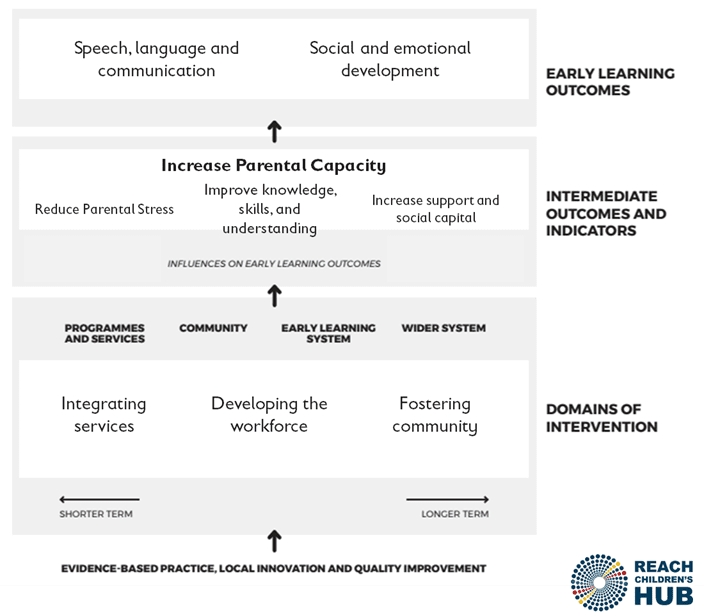Working within a local context to support the Early Years workforce

Katherine Richards-Bryant, Early Education Lead, Reach Children’s Hub, UK
An excellent education at an inclusive school is necessary but not always sufficient for young people to enjoy lives of choice and opportunity. With the awareness that many students require deeper and more wide-ranging support than a school can provide, the Reach Foundation developed the Reach Children’s Hub to provide an integrated pipeline of support for children, young people and families in Feltham. The Hub and Reach Academy work closely to ensure that local children and young people have the support that they need to be safe and healthy, to achieve well academically and to develop strong relationships and networks. The Reach Foundation’s vision is to enable babies, children, young people and families to enjoy a life of choice and opportunity. Consequently, we have created a ‘cradle to career’ (C2C) pipeline of support for families in Feltham and are helping communities around the country to develop their own C2C models.
The Reach Foundation’s Overarching Theory of Change (Figure 1)

The Reach Children’s Hub Theory of Change for improving early learning outcomes (Figure 2)

We take a socio-ecological perspective for our work, believing that we need to work with and within the many interconnected systems surrounding the child to have the biggest impact (Bronfenbrenner, 1979) (see Figure 1 and Figure 2). The early years and the vital work that Early Years professionals do are critical to the success of the C2C model, and as a consequence we have created an Early Years Workforce Pipeline (see Figure 3), which enables local professionals to access high-quality professional development and create self-sustaining peer networks. This also reflects the fact that we take an asset-based approach to community development.
The Early Years Workforce Pipeline (Figure 3)

This Early Years Workforce Pipeline was co-designed with local Feltham Early Years stakeholders, including managers of local early years settings and the local authority, to reflect what matters most in the community. This way of working within a local context is important to us because of our place-based model and our commitment to working deeply within a community. In our initial consultation with professionals, we were told that there was a significant need for clear career progression routes for professionals who want to develop in their career.
A core component of this Pipeline is Kingston University’s Early Years foundation degree, which we deliver locally in Feltham as one of the university’s partner colleges. We have been told by many of our students that the local delivery of the course has given them the incentive to pursue further education when it may not have felt so accessible to them in the past. Furthermore, we believe that teaching and learning has benefited significantly from students bringing their own knowledge and understanding of the local context to lectures. This has also meant that we have been able to curate the content of the course to best reflect local families and the mechanisms of the wider system around them.
This course is available for any local professional who wants to deepen their knowledge of the Early Years and further their professional development. One of the requirements of the course is that students need to currently be working a minimum of 16 hours per week in an Early Years setting. This requirement is particularly pertinent, as it is important to us that this course is as accessible as possible to a wide range of professionals. The fact that the course is work-based means that professionals are able to study and work at the same time, making this next step in their development more financially viable. In addition, studying in this way enables students to make links between theory and practice in a much more dynamic way.
We would like to share the story of a local parent who, through accessing our Early Years Pipeline, has started her journey towards her dream of achieving qualified teacher status. Prior to having children, Lottie (not her real name) worked in several roles related to training and management. After having two children of her own, she began to think about moving into a career that would complement this new stage in her life. When Lottie’s oldest child started nursery school, she started to notice transferable skills from her own career to the skills being demonstrated by the Early Years professionals working with her child. Consequently, when the school advertised a teaching assistantAn adult that assists a teacher in the classroom course for parents, Lottie took up the offer. The study, alongside the voluntary placement, gave her the impetus that she needed, and she discovered that she really enjoyed being in an educational environment. Since that qualification, Lottie has worked in several year groups and has also progressed to become an ‘associate teacher’ in a relatively short space of time. When we started to recruit for our first cohort of students, she was approached by the headteacher and, after some thought, she applied and was successful. Over the last two years, Lottie has been an extremely dedicated student, who has been able to balance work and study with a busy family life. Her knowledge of Early Years theory and pedagogy has deepened and she is now more keen than ever to become a qualified teacher. Excitingly, Lottie has been accepted onto the Kingston University BA top-up course and hopes to then embark on her teacher training.
The design of this course has helped Lottie to balance all of her responsibilities. She has been able to continue working full time and she has a short journey home after lectures as she lives in Feltham. Furthermore, as a parent of young children currently using local educational providers, Lottie has been able to bring her experience as a parent in Feltham into her practice and her academic study. Consequently, the whole cohort is all the richer for it. For example, in a recent lecture, we were discussing the impact of the pandemic on the development of young children. Lottie raised concerns about the oral health of many of the children that she teaches – observations that she made during home visits at the beginning of the year. She was then able to link her own experience of taking her children to the dentist and the limited availability of spaces. As a consequence of this discussion, we were able to raise this issue with the local authority and organise oral health training for children, parents and professionals in the school. This is an example of how the development of the workforce through our cradle to career pipeline can have an impact on young children in the local area. In addition, current students, including Lottie have, told us:
The best thing about the course is the well-thought-out structure of the lectures and the support from the tutors to link theory to practice, allowing me to reflect on my setting and grow my knowledge of all things Early Years.
Completing the degree has given me the confidence to relay back to other members of staff, including managers, new things that I have learnt and why I want to implement them. And to be able to back up my ideas with theory.
Furthermore:
- One hundred per cent of second year students told us that their subject knowledge has increased as a result of this course
- Eighty per cent of second year students have told us that their professional confidence has increased as a result of this course
- Ninety per cent of second year students have told us that they see an increased value in their role as an Early Years professional.
Finally, we believe that Lottie’s story also highlights the importance of parental engagement in relation to the Early Years. Although Lottie came to an educational profession relatively later in life, and thus might be seen as a ‘non-traditional’ student, the close relationships built between her and her children’s school enabled the seed to be planted. Lottie was able to be inspired by the work of the professionals through their close relationships and they, in turn, were able to learn about her assets and aspirations for the future. This close relationship has continued throughout her studies, and the school remains committed to supporting and investing in her career development.
We believe that when professionals are well supported, highly skilled and work in partnerships with families, the learning and care of children and the community will be enriched. Having a clear pipeline of opportunity enables professionals to see the exciting choices that a career in Early Years can offer. However, any work in this area needs to be grounded in listening: listening to the needs of babies and children, listening to the experiences of families and listening to the ideas of professionals.
Conflict of interest statement: The author of this article is a paid employee of the Reach Children’s Hub, which is delivering the foundation degree described in this article.
References
- Bronfenbrenner U (1979) The ecology of human development. London. Harvard University Press











